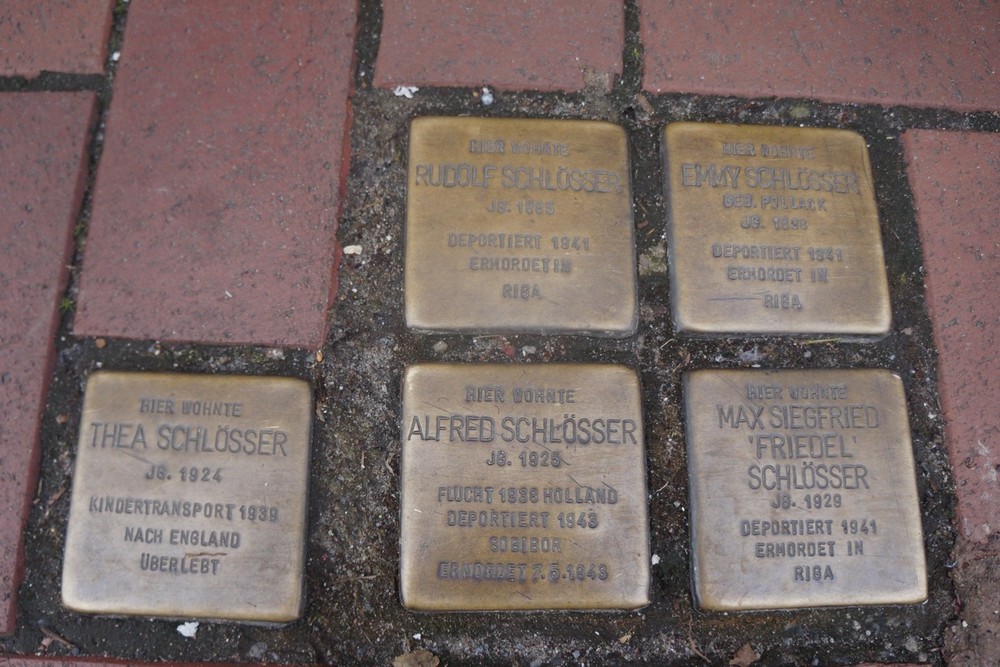Stumbling Stones Wessumer Straße 5
These memorial stones (Stolpersteine or stumbling blocks) commemorate:
* Rudolf Schlösser, born 1885, deported 1941, murdered in Riga.
* Emmy Schlösser, née Pollack, 1898, deported 1941, murdered in Riga.
* Alfred Schlösser, born 1925, deported 1943, Sobibor, murdered 7 May 1943.
* Max Siegfried ‘Friedel’ Schlösser, born 1929, deported 1941, murdered in Riga.
* Thea Schlösser, born 1924, Kindertransport 1939 to England, survived.
The Schlössers' story is one of trying to protect the children. Rudolf Schlösser was a successful livestock trader and he and his wife Emmy had 3 children – Alfred, Max Siegfried (called Friedel) and Thea. From the beginning of Nazi rule, the Schlössers were harrassed as Jews and their income fell dramatically due to the anti-Jewish boycott.
First the parents sent their youngest son, Friedel, to one of his mother’s relatives; in 1941 he briefly attended school at the Jewish orphanage in Paderborn before returning home to Ahaus, just before the deportation.
In May 1938, 14-year-old Thea was sent to live with an aunt in Jülich. A year later (August 1939), Thea was sent on a Kindertransport to England.
Three months later, on Kristallnacht (9 November 1938), Rudolf Schlösser was seriously injured and the family house destroyed. The next day, son Alfred went to the Netherlands to live with his aunt Karoline Groenheim. In 1941 he was an apprentice in a machine construction company.
The Schlösser house on Wessumer Strasse was transformed into a Jewish ghetto house where several Ahaus families were forced to live (so that their own houses could be taken by the "Aryans"). In this house lived Rudolf and wife Emma, Moritz Cohen’s family of 5, Irma Gottschalk’s family of 4 and Moses de Jong’s family of 4.
Thea Schlösser lived: she was the sole survivor of the two Schlösser families from Ahaus. From England she emigrated to California and married there. Students from the Anne-Frank-Realschule in Ahaus researched her story and were able to contact her in the summer of 2007.
Stolpersteine for Rudolf’s siblings are at Wallstraße 3 in Ahaus.
The small brass plaques, in the pavement in front of houses of which the (mostly Jewish) residents were persecuted or murdered by the Nazis, mention the name, date of birth and place (mostly a concentration camp) and date of death.
In many other cities and villages, mainly in Germany but also in other European countries, the memorials also can be found. There are already many thousands of these plaques and their number is still counting. Almost all Stolpersteine are laid by the German artist himself, Gunter Demnig.
Do you have more information about this location? Inform us!
Source
- Text: Fedor de Vries & Anne Palmer
- Photos: Arjan Hell
- VHS Arbeitskreis Ahauser Geschichte
- Anne-Frank-Realschule, AhausGo2War2.nlGo2War2.nlGo2War2.nlGo2War2.nlGo2War2.nlGo2War2.nlGo2War2.nlGo2War2.nl
Nearby
Point of interest
- Plaque and War Damage Parish Church of St. Maria Ascension - Ahaus
- V2 Missile Emplacement Heek - Heek
Monument
- Memorial Stone Deported Jews Ahaus - Ahaus
- Memorials War Damage Schloss Ahaus - Ahaus
- Memorials Old Town Hall Ahaus - Ahaus
Cemetery
- German War Graves Old Cemetery Ahaus - Ahaus
- German War Graves New Cemetery Ahaus - Ahaus
- Memorial Stone Cemetery Wüllen - Wüllen (Ahaus)





